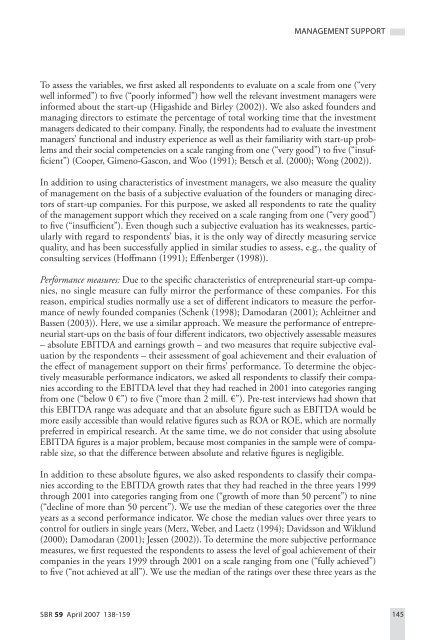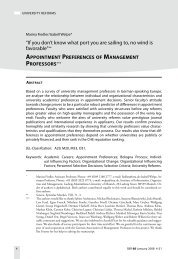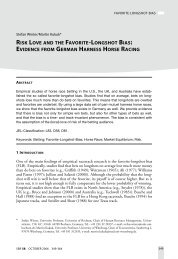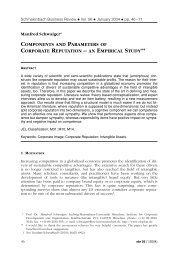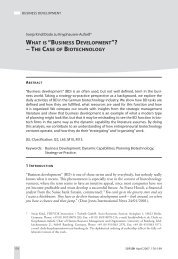management support and the performance of entrepreneurial start-ups
management support and the performance of entrepreneurial start-ups
management support and the performance of entrepreneurial start-ups
You also want an ePaper? Increase the reach of your titles
YUMPU automatically turns print PDFs into web optimized ePapers that Google loves.
MANAGEMENT SUPPORT<br />
To assess <strong>the</strong> variables, we fi rst asked all respondents to evaluate on a scale from one (“very<br />
well informed”) to fi ve (“poorly informed”) how well <strong>the</strong> relevant investment managers were<br />
informed about <strong>the</strong> <strong>start</strong>-up (Higashide <strong>and</strong> Birley (2002)). We also asked founders <strong>and</strong><br />
managing directors to estimate <strong>the</strong> percentage <strong>of</strong> total working time that <strong>the</strong> investment<br />
managers dedicated to <strong>the</strong>ir company. Finally, <strong>the</strong> respondents had to evaluate <strong>the</strong> investment<br />
managers’ functional <strong>and</strong> industry experience as well as <strong>the</strong>ir familiarity with <strong>start</strong>-up problems<br />
<strong>and</strong> <strong>the</strong>ir social competencies on a scale ranging from one (“very good”) to fi ve (“insuffi<br />
cient”) (Cooper, Gimeno-Gascon, <strong>and</strong> Woo (1991); Betsch et al. (2000); Wong (2002)).<br />
In addition to using characteristics <strong>of</strong> investment managers, we also measure <strong>the</strong> quality<br />
<strong>of</strong> <strong>management</strong> on <strong>the</strong> basis <strong>of</strong> a subjective evaluation <strong>of</strong> <strong>the</strong> founders or managing directors<br />
<strong>of</strong> <strong>start</strong>-up companies. For this purpose, we asked all respondents to rate <strong>the</strong> quality<br />
<strong>of</strong> <strong>the</strong> <strong>management</strong> <strong>support</strong> which <strong>the</strong>y received on a scale ranging from one (“very good”)<br />
to fi ve (“insuffi cient”). Even though such a subjective evaluation has its weaknesses, particularly<br />
with regard to respondents’ bias, it is <strong>the</strong> only way <strong>of</strong> directly measuring service<br />
quality, <strong>and</strong> has been successfully applied in similar studies to assess, e.g., <strong>the</strong> quality <strong>of</strong><br />
consulting services (H<strong>of</strong>f mann (1991); Eff enberger (1998)).<br />
Performance measures: Due to <strong>the</strong> specifi c characteristics <strong>of</strong> <strong>entrepreneurial</strong> <strong>start</strong>-up companies,<br />
no single measure can fully mirror <strong>the</strong> <strong>performance</strong> <strong>of</strong> <strong>the</strong>se companies. For this<br />
reason, empirical studies normally use a set <strong>of</strong> diff erent indicators to measure <strong>the</strong> <strong>performance</strong><br />
<strong>of</strong> newly founded companies (Schenk (1998); Damodaran (2001); Achleitner <strong>and</strong><br />
Bassen (2003)). Here, we use a similar approach. We measure <strong>the</strong> <strong>performance</strong> <strong>of</strong> <strong>entrepreneurial</strong><br />
<strong>start</strong>-<strong>ups</strong> on <strong>the</strong> basis <strong>of</strong> four diff erent indicators, two objectively assessable measures<br />
– absolute EBITDA <strong>and</strong> earnings growth – <strong>and</strong> two measures that require subjective evaluation<br />
by <strong>the</strong> respondents – <strong>the</strong>ir assessment <strong>of</strong> goal achievement <strong>and</strong> <strong>the</strong>ir evaluation <strong>of</strong><br />
<strong>the</strong> eff ect <strong>of</strong> <strong>management</strong> <strong>support</strong> on <strong>the</strong>ir fi rms’ <strong>performance</strong>. To determine <strong>the</strong> objectively<br />
measurable <strong>performance</strong> indicators, we asked all respondents to classify <strong>the</strong>ir companies<br />
according to <strong>the</strong> EBITDA level that <strong>the</strong>y had reached in 2001 into categories ranging<br />
from one (“below 0 €”) to fi ve (“more than 2 mill. €”). Pre-test interviews had shown that<br />
this EBITDA range was adequate <strong>and</strong> that an absolute fi gure such as EBITDA would be<br />
more easily accessible than would relative fi gures such as ROA or ROE, which are normally<br />
preferred in empirical research. At <strong>the</strong> same time, we do not consider that using absolute<br />
EBITDA fi gures is a major problem, because most companies in <strong>the</strong> sample were <strong>of</strong> comparable<br />
size, so that <strong>the</strong> diff erence between absolute <strong>and</strong> relative fi gures is negligible.<br />
In addition to <strong>the</strong>se absolute fi gures, we also asked respondents to classify <strong>the</strong>ir companies<br />
according to <strong>the</strong> EBITDA growth rates that <strong>the</strong>y had reached in <strong>the</strong> three years 1999<br />
through 2001 into categories ranging from one (“growth <strong>of</strong> more than 50 percent”) to nine<br />
(“decline <strong>of</strong> more than 50 percent”). We use <strong>the</strong> median <strong>of</strong> <strong>the</strong>se categories over <strong>the</strong> three<br />
years as a second <strong>performance</strong> indicator. We chose <strong>the</strong> median values over three years to<br />
control for outliers in single years (Merz, Weber, <strong>and</strong> Laetz (1994); Davidsson <strong>and</strong> Wiklund<br />
(2000); Damodaran (2001); Jessen (2002)). To determine <strong>the</strong> more subjective <strong>performance</strong><br />
measures, we fi rst requested <strong>the</strong> respondents to assess <strong>the</strong> level <strong>of</strong> goal achievement <strong>of</strong> <strong>the</strong>ir<br />
companies in <strong>the</strong> years 1999 through 2001 on a scale ranging from one (“fully achieved”)<br />
to fi ve (“not achieved at all”). We use <strong>the</strong> median <strong>of</strong> <strong>the</strong> ratings over <strong>the</strong>se three years as <strong>the</strong><br />
SBR 59 April 2007 138-159 145


